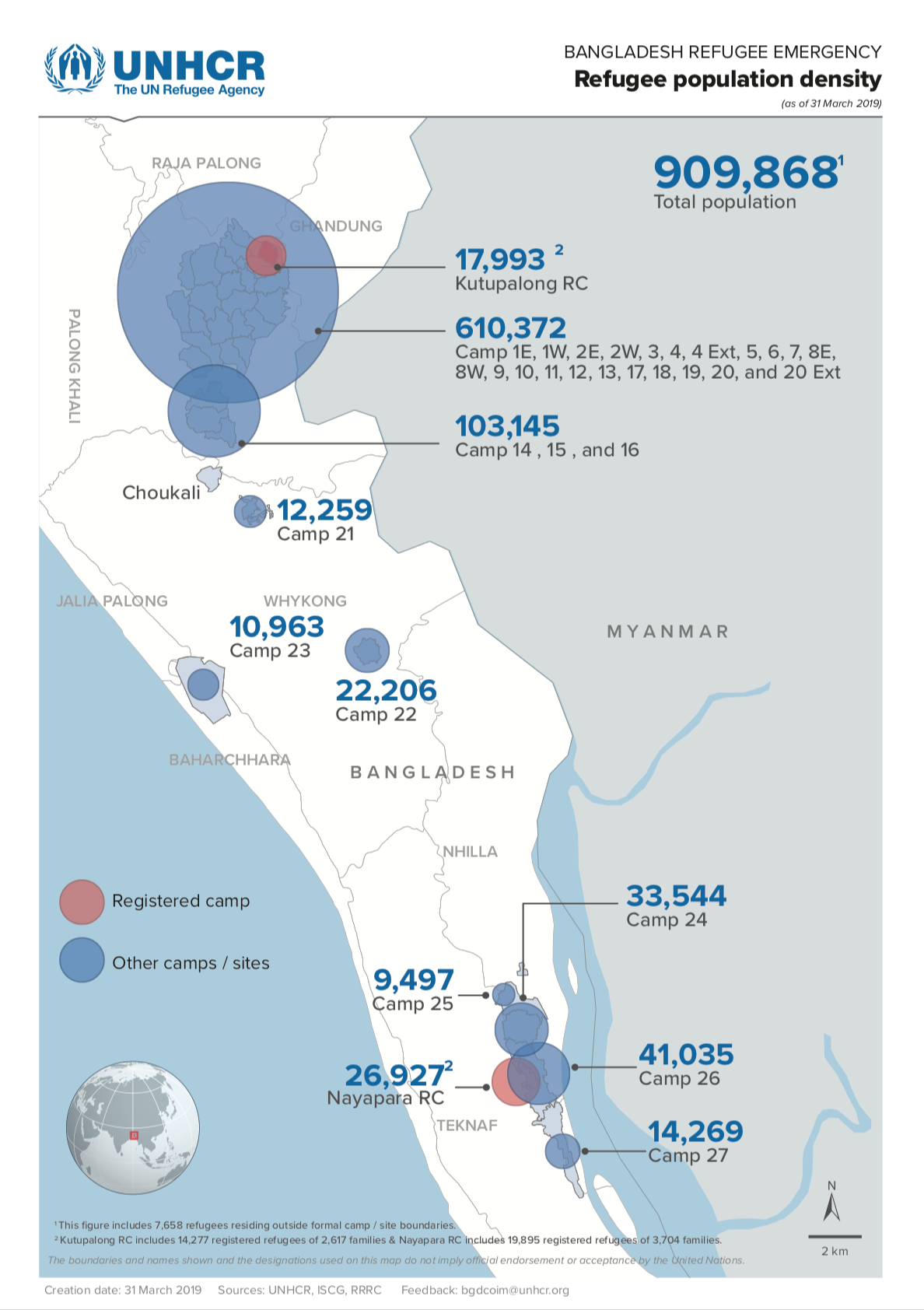“They are absolutely humanitarians, we couldn’t do anything without them. I am thrilled you are using that term. Using the term ‘humanitarians’ is not only empowering but essential to their sense of identify, resilience and self-reliance. With all the trauma they have experienced in the past, the ongoing protection concerns in the present, and their lack of durable solutions or ability to plan for the future, this is vital in their protracted displacement.”
-Emily Reid, DRC
Honoring volunteer and CFW Rohingya workers as ‘refugee humanitarians’
Humanitarians
There are over 500,000 women and men responding to humanitarian crises around the world. Since 2008, each August 19th humanitarians around the globe observe World Humanitarian Day. The theme for this year’s World Humanitarian Day is #WomenHumanitarians, and stories highlighting the heroic efforts of female humanitarians can be found on the UN web site.
 But who are these ‘humanitarians’ being honored? Certainly they include women and men from all over the world working in a dizzying array of capacities, from logistics to security, from drivers to upper management executives, from communications officers to site management specialists. They work for UN agencies (UNHCR, OIM, etc.), with international organizations (INGOs), large and small, or as part of the rich tapestry of national humanitarian organizations (e.g., BRAC).
But who are these ‘humanitarians’ being honored? Certainly they include women and men from all over the world working in a dizzying array of capacities, from logistics to security, from drivers to upper management executives, from communications officers to site management specialists. They work for UN agencies (UNHCR, OIM, etc.), with international organizations (INGOs), large and small, or as part of the rich tapestry of national humanitarian organizations (e.g., BRAC).
Most (exceeding 80%) are from the ‘global South’, the majority world, and many of those are all too familiar with the the realities of a life in crisis, having been both giver and receiver or aid at various points in their lives.
Expand the definition?
In addition to #WomenHumanitarians, for this year’s World Humanitarian Day calling attention to another marginalized group is perhaps warranted.
An incredibly complex industry constantly in flux, the humanitarian ecosystem is not precisely defined, especially at the margins; who is and who is not counted as a ‘humanitarian’ is open to question, at least for some.
There has been much written about ‘professionalizing’ the sector, and I agree with those who critique random ‘do-gooders‘ trying to do aid or development work (there are too many egregious examples to cite). I realize that some might interpret even considering ‘refugee humanitarians’ to be a step in the wrong direction, and I grant that point to those critics. That said, I’ll forge on.
In the last several months I have been learning about the Rohingya refugee emergency and have communicated with over a dozen young men and women, most of whom came to Cox’s Bazar as refugees just after the 25 August 2017 genocide. In my writings I have referred to refugees who volunteer their services to various NGOs as ‘refugee humanitarians.’
By calling refugees that do ‘volunteer work’ or receive ‘Cash for Work’ (CFW) ‘refugee humanitarians’ I am pressing the ‘what is a humanitarian’ question in a different, and I hope meaningful, direction.1
According to one international humanitarian, Emily Reid, a young woman working as an advocacy advisor for the Danish Refugee Council, although there are many technical and even legal issues using the term in official communications, ‘humanitarian’ fits.
Emily had read the many posts I had made commenting on the poetry and work of several young men and women, Rohingya all (see here), and strongly agreed with my characterization. See here for a book of recent Rohingya poetry.
When I asked her about my use of the phrase she says,
“They are absolutely humanitarians, we couldn’t do anything without them. I am thrilled you are using that term. Using the term ‘humanitarians’ is not only empowering but essential to their sense of identify, resilience and self-reliance. With all the trauma they have experienced in the past, the ongoing protection concerns in the present, and their lack of durable solutions or ability to plan for the future, this is vital in their protracted displacement.”
DRC is taking the interagency lead on CFW in the Rohingya response in Bangladesh, and in the past year managed approximately 10,000 men and women -refugee humanitarians- in the sprawling complex of refugee camps in and around Cox’s Bazar. These workers are critical for insuring the smooth functioning of the refugee camps, and are engaged in a wide array of jobs from site management (e.g., clearing roadways) to translation services.

There are many people who do humanitarian work in the sprawling refugee camps in Bangladesh’s Cox’s Bazar -and places like it all around the world where there are humanitarian responses- who are not recognized as professional humanitarians. For a raft of reasons, the members of the affected communities are hired on a ‘temporary’ basis to help serve, most frequently within the refugee camps where they and their families live. Many times they are paid through a variety of programs, and their hours, work duties, and wages are regulated, determined by agreements between the host government, the United Nations, and representatives from the major aid organizations working on location. Depending upon the local context, these individuals may be employed in a variety of ways. In the recent Cyclone Idai response in Mozambique paid locals were used heavily to help distribute critical emergency aid, for example. In Jordan these workers, referred to as Incentive Based Volunteers (IBV), perform many duties both within and outside of the refugee camps.
In most cases these workers are not covered by national labor laws, and as such there is official push back to these women and men being called anything other than ‘volunteers’. I understand that logic, but at the same time I will argue that the term ‘refugee humanitarian’ is a term worth considering, especially if it means opening discussions about the rights of these workers.
So, on this World Humanitarian Day 2019, let us be inclusive and honor these ‘refugee humanitarians.’
Please let me know if you have any comments or feedback. Here’s my email (arcaro@elon.edu).
1 Describing refugees using modifiers is not new. Ibn 1989, thirty years ago, the the ‘refugee warrior’ was used in a book by Ari Zolberg, Astri Suhrke and Sergio Aguayo, Escape from Violence: Conflict and the Refugee Crisis in the Developing World.


 Follow
Follow